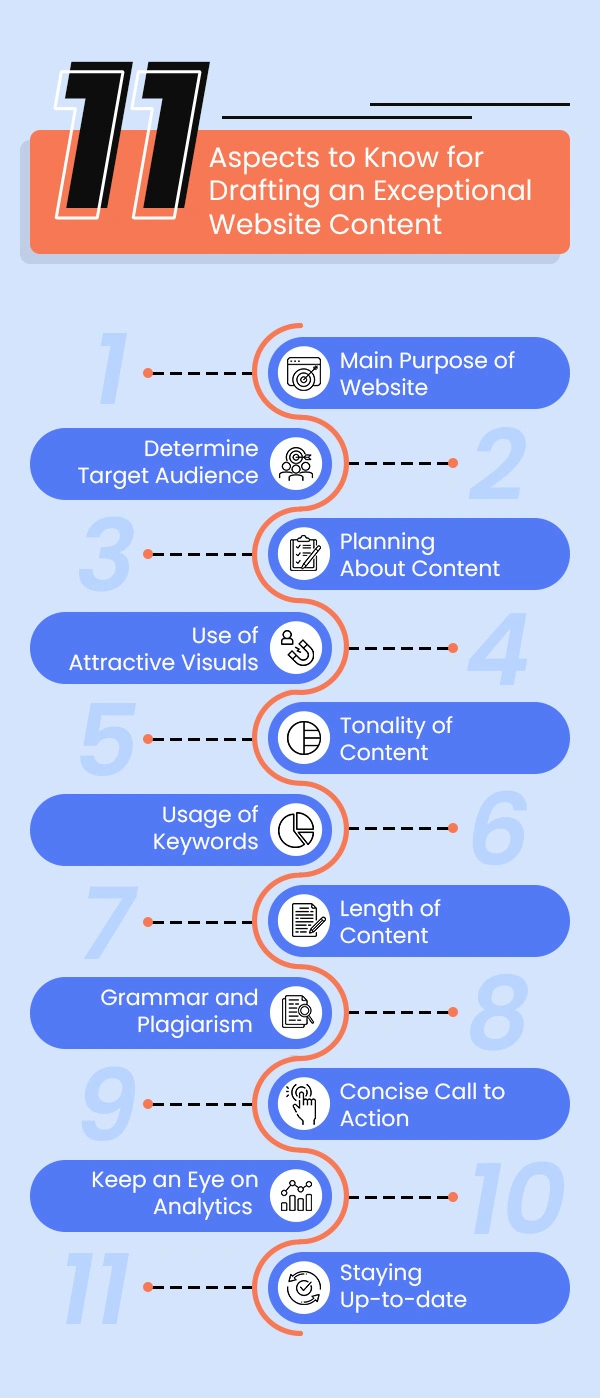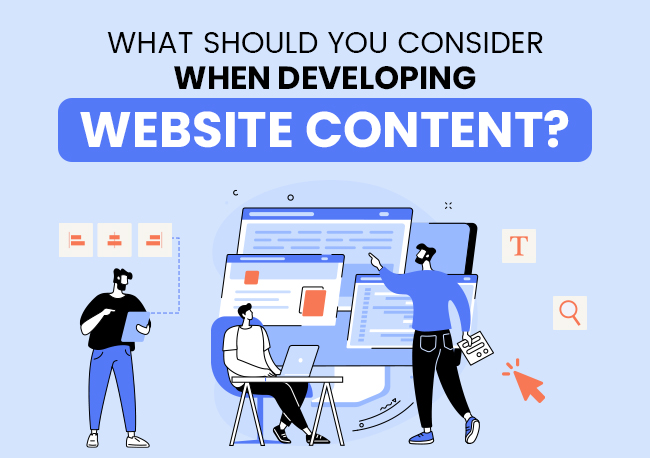When developing a website, web owners consider countless factors such as attractive design, user-friendly interface, unbeatable site speed, and so much more. Why not do the same for your content?
Many web owners tend to overlook website content. You may find common mistakes such as thin or duplicate content and spelling or grammatical errors. However, such minor blunders can make a user assume your website content is unreliable, making you look unprofessional.
Website content is like an individual’s personality — unique. To ensure it stands out and engages your visitors and target audience, you must follow the golden rules of writing website content, which we will discuss throughout this blog.
Let’s dive deep into the things to think when developing website content, shall we?
What is Content?
Content refers to writing a blog, website content, podcasts, articles, copy, etc., on a topic/subject. Generally, the purpose of drafting content is to share information and data or express opinions and ideas to engage, inform, educate, or entertain your target audience.
Importance of Website Content for Online Business
Website content plays a significant role in business. It is a unique personality of your business or brand that helps you beat the competition in the market. You can assume it is a bridge that fills the gap between you and your target audience.
High-quality and well-defined content serving the purpose of users not only retains them on your website but also increases the chances of converting them into a customer.
These pointers were merely the tip of the iceberg. There are numerous benefits of website content, including trust and credibility.
Informative content demonstrating expertise, industry knowledge, and valuable insights convicts readers that your content is well-researched and your website is an authoritative source, increasing credibility.
Furthermore, high-quality content accompanied by the best SEO practices boosts your digital presence and ranking on the SERPs. Overall, website content is one of the most significant facets that every website owner needs to consider.
So far, we have given you a synopsis of the content and its importance in business. We will now be describing the essence of the blog.
Also Read: How Can You Make A Website Look More Professional?
11 Aspects to Know for Drafting an Exceptional Website Content
1. Main Purpose of Website
The initial and most essential facet is identifying the purpose of your website.
- Is your goal to sell products or provide services?
- Do you want to guide or educate your visitors?
- Are you aiming to entertain?
Ask yourself about your objectives, as your content will be partially based on it.
An unclear purpose will lead to drafting vague content, which can confuse your audience as to what your business is about. Hence, clearly define the purpose of your business to align your content accordingly.
Also Read: Best Content Management System Platform Optimized For SEO
2. Determine Target Audience
The second most important step is determining your target audience. The idea behind crafting content is adding value to your user’s search query, which can only be achieved when you identify your target audience.
Specifying your target audience will help you focus and put effort into crafting content resonating with them. You can answer their queries, impart information, share creative ideas, and so much more. Ultimately, you can tailor content to your audience’s preferences.
To define your audience, look for demographics such as age, gender, location, and other essential characteristics. Once you have figured out the demographics, the next step calls for understanding their interests, pain points, etc.
Also Read: Website Optimization Tips To Increase Website Performance
3. Planning About Content
After understanding the fundamentals, it’s time for you to plan and draft content. Before jumping straight to writing content, it is vital to recognize the difference between website content and blogs.
Many web owners perceive both the form of writing as the same. However, they are as different as the night and day.
Website content is known to be a static form of content used for promoting your services, products, and industry expertise or creating awareness about your company.
On the other hand, blogs are dynamic content, frequently uploaded to share valuable insights, creative ideas, educate, and so on. Coming back to our main topic. Since you are already aware of what your target audience wants, it’s time for you to outline the content on the same.
Conduct an extensive research on the topic you plan to write. In case of using statistics or factual information, ensure to utilize them from the relevant and authorized source.
Finally, start drafting the content. Make sure to create a compelling introduction and click-bait title. According to CXL, visitors spend 5.59 seconds on written content which means you have relatively less time to engage them. Hence, make their every second worth it.
Besides the introduction and title of the blog, you also have to focus on the structure. Add H1, H2, and H3 tags to synchronize your content. The usage of bullet pointers should also be considered for highlighting important pointers. Following these pointers will improve the overall readability and navigation of your website content.
4. Use of Attractive Visuals
When creating engaging online content, integrating modern technology can make a significant difference. One such innovation is the use of dynamic QR codes. Understanding how dynamic QR codes work can provide enhanced tracking and adaptability to your marketing efforts. By embedding these into your content strategy, you equip users with easy access while leveraging deep analytic insights to refine user experience.
Most web owners tend to make the mistake of developing text-only websites, which can be less interactive for some users leading to site abandonment.
While text-only content is straightforward and easier to create, we suggest you play with visuals, such as infographics, videos, images, etc., to increase engagement and interaction with your target audience. You can also use a pie chart to present complex data or statistics in a more visually appealing and understandable manner.
It is believed that visuals tend to create more appeal than written content. Visual aids, illustrations, and other creatives offer easy comprehension of complex or challenging topics.
Creatives are also an excellent way to evoke emotions. You can create a strong impact with the graphics encouraging your audience to take action.
Also Read: How To Start Your Travel Website In 2023?
5. Tonality of Content
The tonality of the content entirely depends on the nature of your website, the target audience, and the subject you are writing on. It can be formal, casual, conversational, informative, or other. Although, for it to go hand in hand with your brand’s identity, you can use AI writer with a built-in tone of voice option to automate your content creation process.
You must be consistent with the tonality throughout the website for a cohesive appearance.
6. Usage of Keywords
Ranking on SERPs is not merely about writing content. It is also about following effective SEO practices, including keywords. Incorporate relevant keywords into your content as well as meta descriptions, titles, Alt texts, URLs, and images. It will help in increasing your online visibility and ranking on the SERPs.
Make sure to place them naturally and avoid too much stuffing, as search engines will position your content in an over-optimized category.
Also Read: How Many Keywords Can A Website Use For SEO in 2024?
7. Length of Content
According to Whittington Consulting, the ideal length of the website content should be between 200 to 1000 words. The length will also vary on the topic, its complexity, and your goal. Ultimately, it is all about sharing relevant content with the right audience.
8. Grammar and Plagiarism
Avoid making grammatical, spelling, and punctuation errors. You might consider them as minor mistakes. However, these small blunders can be reflected as a poor impression.
Taylor and Francis Online say a user takes 0.05 seconds to form an opinion regarding your website, which will determine whether they will revisit your site or abandon it altogether.
We recommend you leverage online tools like Grammarly, Quillbot, and Hemingway Editor. These tools will detect potential errors in your content and provide you with suggestions for improvement.
Likewise, be attentive to plagiarism. After drafting and proofreading the content, scan it in either of the tools such as Quetext, Small SEO Tools, Duplichecker, etc. These free tools will scrutinize your content and highlight the results of plagiarism, if any.
9. Concise Call to Action
Website content would always remain incomplete without a click-bait CTA. Create a compelling hook link to prompt a user into making a move. Use action words such as call now, join now, sign up today, start now, it’s free, etc., to persuade users to click the CTA button.
You can also include effects or animations, like a spinning wheel, Q&A section, and so on, to spark users’ curiosity. To supercharge your marketing efforts, enhance interactivity, and bridge the gap between your offline and online strategies, consider using a QR code for website content as a convenient way to direct users to a specific webpage or online resource quickly. You can use a QR code generator to generate your QR code.
10. Keep an Eye on Analytics
Finally, your content is all set to go live. However, your job is not over here! Keep an eye on the analytics after uploading your content to the website. Check your keywords’ performance, generate data on user’s behavior scrolling through the content, measure your position on the SERPs, and similar other metrics.
The analytical reports will help determine your strengths and areas for improvement, allowing you to make informed decisions.
Also Read: 15 Best SEO Audit Tools For Your Website (Free+Paid)
11. Staying Up-to-date.
The last thing is keeping your website content up to date. Google emphasizes websites with relevant, fresh, and authentic content. We advise you to follow the same practice.
You might wonder how often website content should be updated. The frequency will depend on the industry and search engine changes. You need to revamp your content as soon as you come across new insights, best practices, algorithm updates, or regulatory requirements.
Besides this, the upgrades also rely on user engagement and content performance. Be attentive to page views, session time, and bounce rate, as these analytics will reflect user interaction with the content and whether the pages are performing well or losing their relevance.
Refurbishing content is also influenced by your requirements. For instance, you may update the content upon adding new content or promoting any seasonal offers, events, etc.
In addition, we also advise you to eliminate thin, duplicate, outdated, or misinformed content. Fix broken links in your content, if any. Considering that you are aware of aspects to focus on when developing. We shall now be discussing how to develop content.
Let’s have a recap of what we learned about drafting content with an infographic below:

How to Develop Content for a Website?
1. Research on Target Audience & Competitors
Previously, we gave you an overview of why identifying your target audience is essential for content development. Now we will explain to you why segregating your competitors is indispensable.
Stepping into an unknown territory is like a wild goose chase. Hence, knowing the ins and outs of your competition is paramount. See what type of content they are creating, which type of service/products they are highlighting, what their tonality is, and how they promote the content.
Don’t forget to analyze their position on SERPs and how they segment their target audience. We also advise you to check how many images they use in their content and what is the length of their content.
2. Keyword Research
Before jumping into the development of content, it’s imperative to do keyword research. Determining keywords are followed by two main elements – Relevance and Volume.
Glance into high-performing and relevant keywords related to your topic and industry. You also need to look out for user-search queries. For instance – users may search for the best food in Bali or places to eat in Bali, and if you have a restaurant in the same destination, including these keywords in your content will help you reach out to your target audience.
Make sure you focus not only on long-tail but also on short-tail and LSI keywords. Use Excel to create a list of the keywords, and it would be best to segment the keywords into two categories – primary and secondary.
Include primary keywords in the URL, meta titles, descriptions, titles, headings, introduction, and other sections of your content. At the same time, use secondary keywords in the content, H2, and H3, conclusion, etc.
3. Content Creation
User engagement is the most vital factor in content creation. If users are impressed with your website and content on the first go, they will frequently visit it to use services and buy products. You must ensure that your content is quirky enough to grab their attention right from the start.
Craft quirky titles, headers, and compelling introductions. Your introduction can start with a question mark, mind-blowing statistics, or an interesting idiom. Create a buyer persona in the content for better relatability. Add keywords that naturally fit with the content.
Maintain a structure, focus on readability, and ensure that your content adds value and solves the purpose of them visiting your website. Lastly, avoid grammatical errors and duplicate or thin content. You can make use of the best tools to avoid grammatical errors in your content.
4. Content Optimization
After drafting your content, the next step is to optimize it for ranking on SERPs. Besides adding keywords to your overall content, you also have to add them in meta titles, descriptions, header tags, and internal links. This effective practice guarantees visibility on the SERPs and increases the chances of reaching your target audience.
5. Promotion
Promoting your content to the right platforms will forge a path for you to get up close with your target audience and stay at the top of search engines. Upload stories of your website on the social media accounts like Instagram, Linkedin, and Facebook.
You can also share your website and the content as a direct message to the users. Email marketing is another alternative to marketing your content.
You can run ads, collaborate with influencers, create Youtube videos about your products, services, or company, and join online communities to share your website and its content with them.
Frequently Asked Questions About Website Content
High-quality, relevant, quirky, yet informative content helps enhance digital presence and reach the top of SERPs. You can generate organic traffic, engage users and hopefully convert them into customers. All in all, website content is one of the most substantial elements of SEO. A more strategic approach to content marketing can be achieved by leveraging the power of a virtual marketing assistant for increased accuracy and efficiency.
The four P’s of content development are purpose, planning, production, and promotion.
The 4 C’s of content marketing refers to context, content, channel, and community.
No, you should never copy another website’s content. Even if you do, search engines will not index it and categorize it as plagiarized content. You can take other websites as a reference to gain information and create content.
Using ChatGPT integration for research on website content is a good idea. However, don’t copy it. Think of the information as an inspiration and create something unique with it.
Look out for analytics to evaluate whether your website is going in the right direction. Monitor the page views, user sessions, bounce rate, etc., to improve the overall effectiveness of your content and enrich the user experience.
To Conclude
We hope our tips will help you form engaging and valuable content that paves your way toward achieving a desired goal. In conclusion, stay fresh with your content.
Every day you will discover new things on the internet. Algorithms, search queries, SEO strategies, user preferences, theories, information, and so much more change from time to time. Why does your content remain the same?
Stay up to date with trends and the changes the internet brings you!




